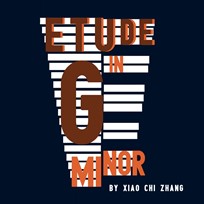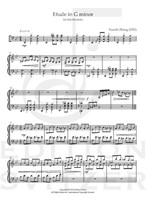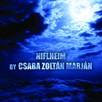
Etude in G minor
Composer: Xiaochi Zhang
Instrument: Marimba
Level: Advanced
Published: 2023
Price: €18.00
Item details
-
Description +
-
Etude in G minor was commissioned by Anders Kann Elten, percussion teacher at the Royal Danish Academy of Music. This piece was created to explore more possibilities of marimba techniques. The composition maintains a consistent rhythmic pattern throughout, based on 6/8-time signature. By employing variations in harmony and melody, the etude introduces new methods of coordination between the four mallets, challenging traditional approaches to melodic performance. It is a great etude to develop four-mallet techniques.
-
-
Instrumentation +
-
Marimba (5-octave)
-
-
Watch+
-
Performed by Tanel Eiko Novikov
-
-
About the composer +
-
Lucky Bell Music Artist
Principal Percussionist of CCOM Symphony Orchestra
Founding member of Jinji Percussion Group
Mr. Zhang, a distinguished musician, was born in 1990 in Xi'an, Shanxi Province, into a family with deep musical roots. His childhood was immersed in the world of music, and he began studying piano at a young age. Displaying remarkable talent, he quickly made a name for himself in the music scene.
His prodigious abilities on the percussion led him to achieve notable accomplishments early on. He garnered the top honors in the inaugural national wind and percussion competition, followed by another resounding victory in the second national percussion competition for young musicians.
In 2010, Mr. Zhang embarked on a transformative journey when he was accepted into the renowned Royal Conservatory in Denmark. There, he participated in a prestigious one-year exchange program, studying under the guidance of acclaimed percussion professors, including the esteemed Gert Mortensen. During this time, he mesmerized audiences with a highly successful solo concert in Denmark, leaving an indelible impression.
With an insatiable thirst for artistic growth, Mr. Zhang furthered his education at the Central Conservatory of Music, where he graduated in 2014. It was during this time that he had the privilege of performing with the National Centre for the Performing Arts Orchestra, gracing the stage under the baton of world-renowned conductors such as Zubin Mehta, Eschenbach, Maazel, Mortensen, Johan, Hakon, and others.
In addition to his virtuosity as a performer, Mr. Zhang is an accomplished composer. His composition, "Light and Shadow: Concerto for Two Percussions," had its triumphant premiere at the National Concert Hall in Taipei in 2016, captivating audiences and earning widespread acclaim. This success paved the way for a series of renowned Chinese percussion works, including "The Rising Sun" for ethnic orchestra, "Hero" for ethnic percussion concerto, "Different Path" for percussion duet, and "Strikeast" for ethnic percussion ensemble. These compositions bear witness to his mastery of form, rich cultural influences, and artistic depth.
Presently, Mr. Zhang holds the position of principal percussionist in the Symphony Orchestra of the Central Conservatory of Music. Through his impeccable artistry and unwavering commitment to his craft, he continues to captivate audiences and inspire fellow musicians. Mr. Zhang's remarkable journey has left an indelible mark on the world of music, cementing his status as a true luminary in the field.
-
-
Reviews +
-
Review (Percussive Notes, June 2024)
This challenging 4-mallet marimba solo can easily serve a number of performance needs and will impress all sorts of audiences. The piece takes the form of a dance, with a steady triple meter that is interrupted by the occasional quasi-cadenza non sequitur, and although the etude doesn’t suggest itself as the centerpiece of a recital program at just over five minutes in length, it nonetheless will require enormous technical and artistic facility to do it justice. The piece is an “etude” in the sense that, in the words of the composer, its intention is “to develop fourmallet techniques.” But make no mistake: this is a concert-worthy project for advanced performers, and early to intermediate marimbists will find themselves in over their heads.
This piece sounds like a bit of a mashup between Bach and Liszt, with a pinch of Schubert thrown in. The harmonies are ephemeral and often chromatic, which combine with the throatiness of the low range to produce a piece that is velvety and dark. The greatest thrills and challenges of the piece are the long breathless stretches of two-voice polyphony in which the performer’s hand and mallet independence is on full display. Performers will also have to give serious thought to mallet selection; much of the piece explores the low range playfully and with motion, but there are more than a few detours up into the highest octave as well.
If you are looking for a piece that will provide a substantial technical challenge and provoke diehard proponents of conservative Baroque harmony, I recommend giving this piece a look.
—Brian Graiser
-
-
Credits +
-
Front Cover Graphics and Layout: Nicola Lee
Photo: Shu Su
Printed in Copenhagen, Denmark
Copyright © Edition SVITZER
-





